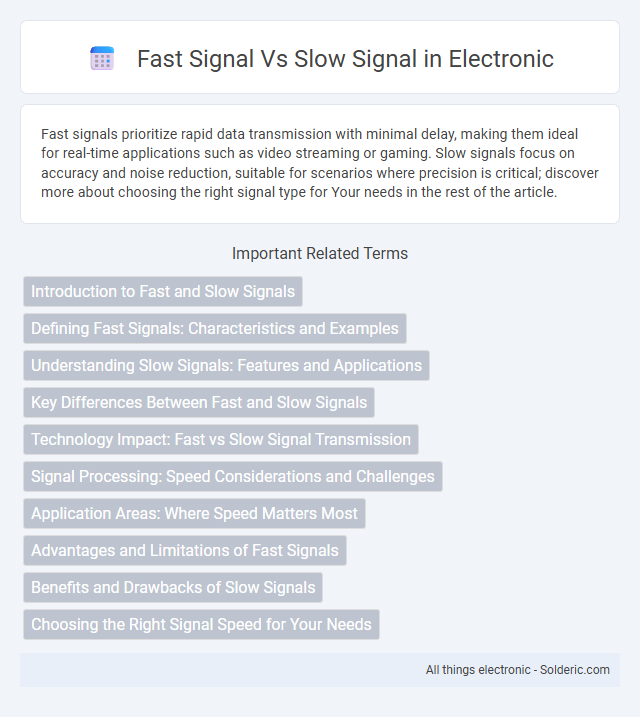Fast signals prioritize rapid data transmission with minimal delay, making them ideal for real-time applications such as video streaming or gaming. Slow signals focus on accuracy and noise reduction, suitable for scenarios where precision is critical; discover more about choosing the right signal type for Your needs in the rest of the article.
Comparison Table
| Feature | Fast Signal | Slow Signal |
|---|---|---|
| Speed | Quick response, instantaneous | Delayed response, gradual |
| Transmission | Electrical or neural impulses | Chemical or hormonal signals |
| Duration | Short-lived | Long-lasting |
| Example | Reflex actions, nerve impulses | Growth hormone, insulin regulation |
| Function | Immediate control and coordination | Regulation and maintenance of body functions |
Introduction to Fast and Slow Signals
Fast signals transmit data at high frequencies with rapid transitions, enabling real-time processing and immediate response in digital systems. Slow signals operate at lower frequencies and longer rise times, often used for control or monitoring where speed is less critical. Understanding the distinction between fast and slow signals is crucial for optimizing circuit design and ensuring signal integrity in electronic applications.
Defining Fast Signals: Characteristics and Examples
Fast signals are electrical or electronic signals characterized by rapid rise and fall times, typically in the nanosecond or microsecond range, enabling high-speed data transmission and real-time processing. Examples include clock pulses in digital circuits, high-frequency communication signals, and rapid switching signals in microcontrollers. Understanding the characteristics of fast signals allows you to optimize circuit design for performance and minimize signal distortion or delay.
Understanding Slow Signals: Features and Applications
Slow signals are characterized by gradual changes over time, making them ideal for monitoring trends in environmental data, physiological measurements, and economic indicators. Their low frequency and stable amplitude enable precise analysis of long-term behaviors and patterns, supporting applications such as climate modeling, heart rate variability studies, and financial forecasting. Technologies like low-pass filters and digital signal processing algorithms enhance the extraction and interpretation of slow signal data in various scientific and engineering fields.
Key Differences Between Fast and Slow Signals
Fast signals feature rapid rise and fall times, enabling high-frequency data transmission essential for applications like digital communications and high-speed computing. Slow signals change gradually, ideal for controlling systems or sensing environments where timing precision is less critical but stability is paramount. Understanding these key differences allows you to select the appropriate signal type for optimized performance in electronics and signal processing tasks.
Technology Impact: Fast vs Slow Signal Transmission
Fast signal transmission technologies, such as fiber optics and 5G networks, significantly enhance data transfer rates and reduce latency, enabling real-time applications like autonomous vehicles and remote surgery. Slow signal transmission methods, often relying on older copper cables or lower-frequency radio waves, limit bandwidth and speed, impacting the efficiency of large-scale data processing and cloud computing. The technological shift towards faster signals drives innovation in Internet of Things (IoT) devices, smart cities, and advanced telecommunication infrastructures, fostering economic growth and connectivity.
Signal Processing: Speed Considerations and Challenges
Fast signals enable rapid data transmission and real-time processing but demand high bandwidth and advanced noise reduction techniques to maintain integrity. Slow signals offer better noise immunity and easier filtering but introduce latency and limit system responsiveness. Your choice of signal speed impacts overall system performance, balancing speed requirements against processing complexity and accuracy challenges.
Application Areas: Where Speed Matters Most
Fast signals are critical in high-frequency trading, real-time gaming, and live video streaming, where milliseconds impact user experience and financial outcomes. Slow signals find applications in environmental monitoring, temperature sensing, and HVAC systems, where data accuracy and stability are more important than immediate response time. Choosing between fast and slow signals depends on the specific latency requirements and precision needs of each application area.
Advantages and Limitations of Fast Signals
Fast signals enable rapid communication and data transfer, crucial for applications requiring low latency, such as high-frequency trading and real-time monitoring systems. Their advantage lies in minimizing delays and improving responsiveness, but they often consume more power and may suffer from reduced accuracy or increased noise susceptibility in complex environments. Limitations include higher implementation costs and challenges in maintaining signal integrity over long distances or through interference-prone media.
Benefits and Drawbacks of Slow Signals
Slow signals enhance data stability and reduce noise interference, making them ideal for precise measurements and long-term monitoring in control systems. However, the inherent latency limits their effectiveness for real-time applications requiring rapid response, potentially causing delays in decision-making processes. The trade-off between accuracy and speed necessitates careful consideration based on application requirements.
Choosing the Right Signal Speed for Your Needs
Fast signals excel in real-time data transmission, ideal for applications demanding low latency such as live streaming and gaming, while slow signals are better suited for tasks requiring high reliability and signal stability like sensor networks and industrial controls. Selecting the right signal speed depends on balancing your need for speed against accuracy and power consumption. Understanding these trade-offs ensures optimal performance tailored to your specific communication requirements.
fast signal vs slow signal Infographic

 solderic.com
solderic.com